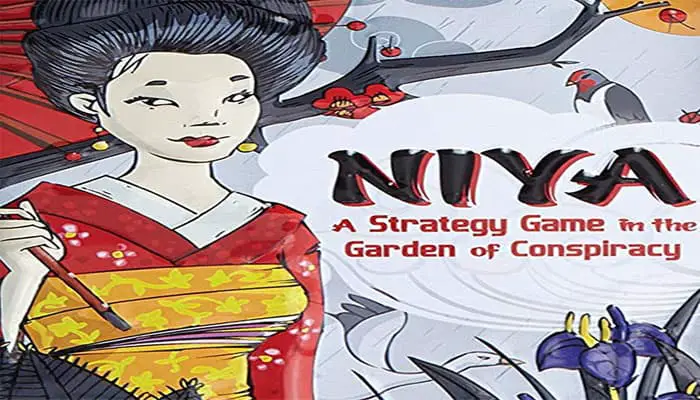
It's the late age of Classical Japan and two influential families, the Genji and Heike clans are competing for power at court. In the Imperial Garden, courtly manners and natural beauty veil a dark political conspiracy.
Each representing a clan, players must follow the patterns set by their rival to position their tokens in one of the victory conditions. Strategy and shrewd decisions will lead your clan to seize control of the garden... and power at court!

Components
- 16 Garden Tiles
- 8 Red Genji Tokens
- 8 Black Heke Tokens
- Rulebook
Object of the Game
The goal of the game is to achieve one of the following victory conditions:
- Line up H members of your clan in a horizontal, vertical or diagonal row.
- Arrange a 2 x 2 square of 4 clan members.
- Block your opponent so that they have no more legal moves.
Garden Tile Elements
Each garden tile is composed of 2 elements, one plant (maple leaves, Cherry tree, Pine tree, Iris) and one poetic symbol (Rising sun, Poem flag, Bird, Rain cloud).

note: All of the different species of birds are counted as the same type of element (bird).
Setup
Shuffle the 16 garden tiles and randomly arrange them face-up in a H x H grid to form the Imperial Garden.
Players choose one of the clans (Heike or Genji) and place the corresponding stacks of tokens on opposing sides of the garden.

Game Play
The game is played in turns with the youngest player going first.
On your turn, choose a garden tile to replace with one of your clan tokens. Set aside the garden tile and put the clan token in its place on the grid. If you are the first player, the chosen tile must be on the outside border of the garden (the H middle tiles are out of bounds). This is only required for the first turn of the game.
The next player must then exchange a token for a garden tile that shares an element in common with the tile that was just removed.
On the following turns, continue to replace garden tiles that have a common element with the tile removed by the previous player, while trying to arrange your tokens in one of the three victory conditions.
The first player to achieve a victory condition wins the game.
Example of play:
In this example, the Genji player chose to exchange their clan token with the garden tile containing the iris and poem flag (Because it was the first turn, the tile had to be on the outside border). The Heike player must now choose from one of the remaining tiles that shares either the iris (Al, A2, A3) or the poem flag (Bl, B2, B3) as one of its elements.
The Heike player chose to remove the garden tile containing the maple leaves and poem flag (B3). now, the Genji player must choose from one of the remaining tiles that either has the maple leaves (Cl, C2, C3) or the poem flag (DI, D2) as one of its elements.
End of the Game
The game ends when a player achieves one of the following victory conditions: I H T
-
A vertical, horizontal or diagonal row of H clan tokens of the same color.

-
A 2 x 2 square of 4 clan tokens of the same color.

-
Blocking an opponent so that they have no legal moves remaining.

In this example, it 15 the Genji player 5 turn. The elements on the previously removed garden tile are the bird and the pine tree. Because there are no more matching elements on any of the remaining garden tiles, the Genji player has no legal moves to choose from, and therefore the Heike player wins the game.
Variation
match of victory points: The winner of a game gains as many victory points as there are garden tiles left in the garden.
The game ends when one player achieves 10 points (for longer matches you can play until one achieves 15 or 20 points).
Continue Reading


